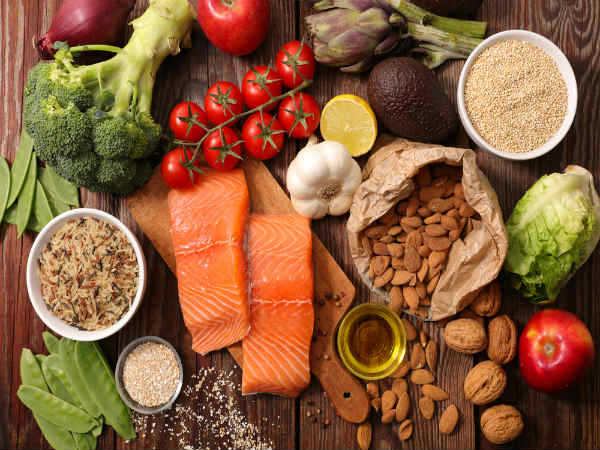
1. Include the five food groups
One of the most important tips of healthy eating is including five major food groups in your diet. The five food groups are fruits, vegetables, protein, carbohydrates and dietary fat. Fruits and vegetables are rich in essential micronutrients and macronutrients that have been shown to protect against chronic diseases and maintain overall health. Eat five portions of a variety of fruits and vegetables daily [4].
Protein, known as the building blocks of the body is another important food group that should be a part of your meal. Proteins are made of amino acids that aids in building cells and repairing tissues. Foods which are rich in protein are chicken, eggs, fish, beans, lentils, milk products, nuts and seeds.
Carbohydrates provide fuel and energy to the body. They are classified as simple and complex carbs. Complex carbs found in whole and unprocessed plant-based foods are considered healthier than simple carbs, which are especially found in processed and sugary foods [5].
Dietary fat supports a number of your body’s functions. Research studies have shown that choosing healthy fats found in nuts, seeds, whole grains, fish and vegetable oils are essential for your health rather than the unhealthy fats found in red meat and whole fat dairy products [4].
 What Is The Volumetrics Diet? Does It Work For Weight Loss?
What Is The Volumetrics Diet? Does It Work For Weight Loss?

2. Have a rainbow diet
A rainbow diet consists of fruits and vegetables of different colours that are packed with essential nutrients. Eating fruits and vegetables from every colour of the rainbow can help provide your body with umpteen health benefits.
Consume a variety of red, yellow/orange, green, blue/purple and white coloured fruits and veggies [6]. The reason some fruits and vegetables are red, purple and blue in colour is due to the presence of water-soluble pigments called anthocyanins. These anthocyanins exhibit anti-inflammatory, anticancer, anti-diabetic, and antimicrobial effects and have also been shown to prevent the risks of heart disease and obesity [7]. Some red, blue and purple coloured foods include tomato, red bell peppers, blueberries and elderberries.
Another study showed that carotenoids that give yellow/orange fruits and veggies their colour can help protect against chronic health problems. Orange/yellow coloured foods are citrus fruits, carrot, pumpkin, sweet potato and peaches, to name a few [8].
READ RELATED: Paxlovid: The New COVID Oral Pill; Will It Be Available In India?
Green coloured fruits and veggies contain a plant pigment called chlorophyll which has been shown to have several beneficial properties. Some green-coloured foods are spinach, broccoli, asparagus, green cabbage and kiwi, to name a few [9].
Anthoxanthins are pigments that give white produce their colour. Potatoes, cauliflower, mushroom, turnips and garlic are some of the white-coloured foods that have a number of health-promoting properties.
 6 Ways To Make Your Diabetic Meal Healthy And Tasty
6 Ways To Make Your Diabetic Meal Healthy And Tasty

3. Limit high-sugar foods
High-sugar foods and drinks such as cakes, pastries, cookies and soda contain added sugars that have been shown to elevate the risk of obesity, heart disease, diabetes, non-alcoholic fatty liver disease and rise in blood pressure levels [10]. So, in order to lead a healthy lifestyle limit the intake of foods high in added sugar.

4. Drink plenty of water
Drinking plenty of water is essential in the proper functioning of the body. Not drinking enough water leads to dehydration and this has a negative impact on your health. So, drink at least seven to eight glasses of water daily to hydrate your body [11].

5. Exercise everyday
Being physically active has a positive impact on your physical and mental health. A study showed that exercising daily can help reduce feelings of fatigue [12]. Other studies have also showed that regular physical activity helps improve your heart health, lowers obesity risk and reduces the risk of diabetes [13], [14] [15].

Other Essential Tips For A Healthy Lifestyle
Here are some more tips that you could follow to lead a healthy lifestyle.
Source:






